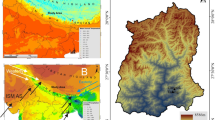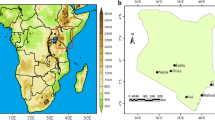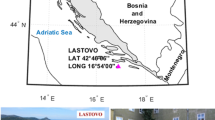Abstract
In the recent years, extreme temperature i.e. cold in winter and warm in summer has been observed in the coastal Odisha state in the east part of India. Hydro-meteorological disasters such as floods, droughts, heat waves and cold spells being experienced nowadays are unprecedented in living memory. In this work the climate variability over the coastal Odisha region is quantified considering the temperature parameter. A climate departure index (CDI) of three versions (simple, absolute and least-square) are calculated using monthly, annually and seasonally maximum, minimum as well as mean temperature form seven stations in the costal Odisha for the period 1969 to 2018 for assessing the degree of normal/unusual/extreme of a particular year in compared to the long-term average for the specific coast under consideration. Temperature time series data for the period 1969 to 2018 are homogenized by using the relative comparison between station observations and composite reference series by calculating CDI. Results indicates that CDI values of least-square on all cases are comparatively greater than simple and absolute CDIs. Least-square method is the appropriate method for determining the category of a year or a month or a season in terms of the temperature variation. Analysis based on mean temperature infers that only twenty extreme seasons are observed in monsoon season while three normal are observed during the month of October i.e., in post-monsoon season over the coastal Odisha. The relationship of climatic event including El Nino or La Nina feature of a particular year with respect to CDI is also investigated. The climatic variability is very high on some of the years based on analysis of index values of annual average of the temperatures (maximum, minimum and mean) over a region.
















Similar content being viewed by others
Data availability
All the data used are publicly available.
References
Alemu, Z. A., & Dioha, M. O. (2020). Climate change and trend analysis of temperature: The case of Addis Ababa, Ethiopia. Environmental Systems Research, 9(1), 1–15.
Alexandersson, H. (1986). A homogeneity test applied to precipitation data. Journal of Climatology, 6(6), 661–675.
Alexandersson, H., & Moberg, A. (1997). Homogenization of Swedish temperature data. Part I: homogeneity test for linear trends. International Journal of Climatology: A Journal of the Royal Meteorological Society, 17(1), 25–34.
Allen, R. G., Pereira, L. S., Raes, D., & Smith, M. (1998). Crop evapotranspiration-Guidelines for computing crop water requirements-FAO Irrigation and drainage paper 56. Fao, Rome, 300(9), D05109.
Angell, J. K., & Korshover, J. (1978). Global temperature variation, surface-100 mb: An update into 1977. Monthly Weather Review, 106(6), 755–770.
Asakura, T., & Ikeda, S. (1981). Recent climatic change and unusual weather in the Northern Hemisphere. GeoJournal, 5, 113–116.
Berry, H. L., Bowen, K., & Kjellstrom, T. (2010). Climate change and mental health: A causal pathways framework. International Journal of Public Health, 55, 123–132.
Bradley, R. S., & Jones, P. D. (1985). Data bases for detecting CO2-induced climatic change. Detecting the effects of increasing carbon dioxide, US Department of Energy, Carbon Dioxide Research Division, Washington DC, 29–53.
Conrad, V., & Pollak, L. W. (1950). Methods in Climatology. Harvard University Press.
Dalle, D., Gecho, Y., & Bedeke, S. B. (2023). Spatiotemporal variability and trends in rainfall and temperature in South Ethiopia: Implications for climate change adaptations in rural communities. Advances in Meteorology. https://doi.org/10.1155/2023/1939528
Das, A., & Tripathy, B. (2020). Long term assessment of rainfall over different districts of Odisha: A case study. IOSR Journal of Mechanical and Civil Engineering, 17(2), 11–22.
De la Casa, A., & Nasello, O. (2010). Breakpoints in annual rainfall trends in Córdoba, Argentina. Atmospheric Research, 95(4), 419–427.
Del Rio, S., Fraile, R., Herrero, L., & Penas, A. (2007). Analysis of recent trends in mean maximum and minimum temperatures in a region of the NW of Spain (Castillay León). Theoretical and Applied Climatology, 90, 1–12.
Del Río, S., Penas, Á., & Fraile, R. (2005). Analysis of recent climatic variations in Castile and Leon (Spain). Atmospheric Research, 73(1–2), 69–85.
Denchak, M. “Are the effects of global warming really that bad?” NRDC. Last modified March 15, 2016. https://www.nrdc.org/stories/are-effects-global-warming-really-bad. Accessed 1 Sep 2023.
Díaz, S., Fargione, J., Chapin, F. S., III., & Tilman, D. (2006). Biodiversity loss threatens human well-being. PLoS Biology, 4(8), e277.
Ducré-Robitaille, J. F., Vincent, L. A., & Boulet, G. (2003). Comparison of techniques for detection of discontinuities in temperature series. International Journal of Climatology: A Journal of the Royal Meteorological Society, 23(9), 1087–1101.
Easterling, D. R., & Peterson, T. C. (1995). The effect of artificial discontinuities on recent trends in minimum and maximum temperatures. Atmospheric Re-Search, 37(1–3), 19–26.
Epstein, P. R. (2002). Climate change and infectious disease: Stormy weather ahead? Epidemiology, 13(4), 373–375.
Gordo, O., & Doi, H. (2012). Drivers of population variability in phonological responses to climate change in Japanese birds. Climate Research, 54(2), 95–112.
Gouda, K. C., Sahoo, S. K., Samantray, P., & Shivappa, H. (2017). Comparative study of monsoon rainfall variability over India and the Odisha State. Climate, 5(4), 79.
Gullet, D.W., Vincent, L., & Malone, L.H. (1991). Homogeneity testing of monthly temperature series, application of multi-phase regression models with mathematical change points. CCC Report No. 91–10. Atmospheric Environment Service, Downsview, Ontario, 47 p.
Gullet, D. W., Vincent, L., & Sajecki, P. J. (1990). Testing for homogeneity in temperature time series at Canadian climate stations. CCC Report No. 90–4, Atmospheric Environment Service, Downsview, Ontario, 43 p.
Heino, R. (1994). Climate in Finland during the Period of Meteorological Observations, Finnish Meteorological Institute Contributions 12. Helsinki, Finland: Finnish Meteorological Institute.
Higuchi, K., Etkin, D., & MacDonald, W. (1986). Trends in the variability of surface air temperature, Canadian Arctic. Physical Geography, 7(4), 306–319.
Jones, P. D., Raper, S. C. B., Santer, B., Cherry, B. S. B., Goodess, C., Kelly, P. M., Wigley, T. M. L., Bradley, R. S., & Diaz, H. F. (1985). A Grid Point Surface Air Temperature Data Set for the Northern Hemisphere, TR022 (p. 251). Department of Energy.
Jones, P. D., Wigley, T. M. L., & Kelly, P. M. (1982). Variations in surface air temperatures: Part 1 Northern Hemisphere, 1881–1980. Monthly Weather Review, 110(2), 59–70.
Jones, P. D., Wigley, T. M., & Wright, P. B. (1986). Global temperature variations between 1861 and 1984. Nature, 322(6078), 430–434.
Kampata, J. M., Parida, B. P., & Moalafhi, D. B. (2008). Trend analysis of rainfall in the headstreams of the Zambezi River Basin in Zambia. Physics and Chemistry of the Earth, Parts a/b/c, 33(8–13), 621–625.
Karl, T. R. (1985). Perspective on climate change in North America during the twentieth century. Physical Geography, 6(3), 207–229.
Karl, T. R., & Williams, C. N., Jr. (1987). An approach to adjusting climatological time series for discontinuous inhmogeneities. Journal of Applied Meteorology and Climatology, 26(12), 1744–1763.
Khasnis, A. A., & Nettleman, M. D. (2005). Global warming and infectious disease. Archives of Medical Research, 36(6), 689–696.
Kloor, K. (2009). The war against warming. Nature Reports Climate Change. https://doi.org/10.1038/climate.2009.120
Kohler, M. A. (1949). On the use of double-mass analysis for testing the consistency of meteorological records and for making required adjustments. Bulletin of the American Meteorological Society, 30(5), 188–195.
Krishnakumar, K. N., Rao, G. P., & Gopakumar, C. S. (2009). Rainfall trends in twentieth century over Kerala, India. Atmospheric Environment, 43(11), 1940–1944.
Laepple, T., Ziegler, E., Weitzel, N., Hébert, R., Ellerhoff, B., Schoch, P., & Rehfeld, K. (2023). Regional but not global temperature variability underestimated by climate models at supradecadal timescales. Nature Geoscience, 16(11), 958–966.
Lamb, H. H. (1982). 1982: Climate, History and the Modern World. Methuen.
Liu, Q., Yang, Z., & Cui, B. (2008). Spatial and temporal variability of annual precipitation during 1961–2006 in Yellow River Basin, China. Journal of Hydrology, 361(3–4), 330–338.
Lobell, D. B., & Gourdji, S. M. (2012). The influence of climate change on global crop productivity. Plant Physiology, 160(4), 1686–1697.
Maniar, K., & Pattnaik, S. (2019). Spatiotemporal patterns of surface temperature over western Odisha and eastern Chhattisgarh. SN Applied Sciences, 1, 1–11.
Matti, C., Pauling, A., Küttel, M., & Wanner, H. (2009). Winter precipitation trends for two selected European regions over the last 500 years and their possible dynamical background. Theoretical and Applied Climatology, 95, 9–26.
Mitchell, J. M. (1953). On the causes of instrumentally observed secular temperature trends. Journal of the Atmospheric Sciences, 10(4), 244–261.
Mohapatra, M., Mohanty, U. C., & Behera, S. (2003). Spatial variability of daily rainfall over Orissa, India, during the southwest summer monsoon sea-son. International Journal of Climatology: A Journal of the Royal Meteorological Society, 23(15), 1867–1887.
Nath, T.K., Tripathy, B., & Das, A. (2018). Climatic change on different Districts of Odisha. International Journal of Engineering Research & Technology, 7(07), 192–204.
Nibal, D., & Damodar, J. (2020). Trend analysis of climate change indicators in Puri District of Odisha, India. Disaster Advances, 13, 43–50.
Panda, A., & Sahu, N. (2019). Trend analysis of seasonal rainfall and temperature pattern in Kalahandi, Bolangir and Koraput districts of Odisha, India. Atmospheric Science Letters, 20(10), e932.
Partal, T., & Kahya, E. (2006). Trend analysis in Turkish precipitation data. Hydrological Processes: An International Journal, 20(9), 2011–2026.
Patz, J. A., Olson, S. H., & Gray, A. L. (2006). Climate change, oceans, and human health. Oceanography-Washington DC-Oceanography Society, 19(2), 52.
Perreault, L., Haché, M., Slivitzky, M., & Bobée, B. (1999). Detection of changes in precipitation and runoff over eastern Canada and US using a Bayesian approach. Stochastic Environmental Research and Risk Assessment, 13, 201–216.
Peterson, T. C., & Easterling, D. R. (1994). Creation of homogeneous composite climatological reference series. International Journal of Climatology, 14(6), 671–679.
Peterson, T. C., Karl, T. R., Jamason, P. F., Knight, R., & Easterling, D. R. (1998). First difference method: Maximizing station density for the calculation of long-term global temperature change. Journal of Geophysical Research: Atmospheres, 103(D20), 25967–25974.
Peterson, T. C., & Vose, R. S. (1997). An overview of the Global Historical Climatology Network temperature database. Bulletin of the American Meteorological Society, 78(12), 2837–2850.
Plummer, N., Lin, Z., & Torok, S. (1995). Trends in the diurnal temperature range over Australia since 1951. Atmospheric Research, 37(1–3), 79–86.
Potter, K. W. (1981). Illustration of a new test for detecting a shift in mean in precipitation series. Monthly Weather Review, 109(9), 2040–2045.
Price, C., Michaelides, S., Pashiardis, S., & Alpert, P. (1999). Long term changes in diurnal temperature range in Cyprus. Atmospheric Research, 51(2), 85–98.
Rhoades, D. A., & Salinger, M. J. (1993). Adjustment of temperature and rainfall records for site changes. International Journal of Climatology, 13(8), 899–913.
Szentimrey, T. (1999). Multiple analysis of series for homogenization (MASH). In: Proceedings of the second seminar for homogenization of surface climatological data (pp. 27–46). Budapest, Hungary: WMO.
Sherwood, S. C., & Huber, M. (2010). An adaptability limit to climate change due to heat stress. Proceedings of the National Academy of Sciences, 107(21), 9552–9555.
Solow, A. R. (1987). Testing for climate change: An application of the two-phase regression model. Journal of Applied Meteorology and Climatology, 26(10), 1401–1405.
Suckling, P. W. (1984). Trends in monthly temperature departures for the contiguous United States, 1940–1983. Physical Geography, 5(2), 150–163.
Suckling, P. W. (1987). A climate departure index for the study of climatic variability. Physical Geography, 8(2), 179–188.
Sugahara, S., Da Rocha, R. P., Ynoue, R. Y., & Da Silveira, R. B. (2012). Homogeneity assessment of a station climate series (1933–2005) in the Metropolitan Area of São Paulo: Instruments change and urbanization effects. Theoretical and Applied Climatology, 107, 361–374.
Taylor, R. G., Scanlon, B., Döll, P., Rodell, M., Van Beek, R., Wada, Y., & Treidel, H. (2013). Ground water and climate change. Nature Climate Change, 3(4), 322–329.
Tol, R. S. (2002). Estimates of the damage costs of climate change, Part II. Dynamic estimates. Environmental and Resource Economics, 21, 135–160.
Venema, V., et al. (2018). Guidance on the homogenization of climate station data. Geneva: WMO. https://doi.org/10.31223/osf.io/8qzrf.
Ventura, F., Pisa, P. R., & Ardizzoni, E. (2002). Temperature and precipitation trends in Bologna (Italy) from 1952 to 1999. Atmospheric Research, 61(3), 203–214.
Vincent, L. A. (1998). A technique for the identification of inhmogeneities in Canadian temperature series. Journal of Climate, 11(5), 1094–1104.
Young, K. C. (1993). Detecting and removing inhmogeneities from long-term monthly sea level pressure time series. Journal of Climate, 6(6), 1205–1220.
Yue, S., & Hashino, M. (2003). Temperature trends in Japan: 1900–1996. Theoretical and Applied Climatology, 75, 15–27.
Zhang, Q., Xu, C. Y., Zhang, Z., Chen, Y. D., & Liu, C. L. (2009). Spatial and temporal variability of precipitation over China, 1951–2005. Theoretical and Ap-Plied Climatology, 95, 53–68.
Zhang, X., & Cai, X. (2013). Climate change impacts on global agricultural water deficit. Geophysical Research Letters, 40(6), 1111–1117.
Acknowledgements
The authors are grateful to the President of Siksha ‘O’ Anusandhan Deemed to be University for providing the necessary support in terms of library facility, technical support and other infrastructures to carry out this research work. We also acknowledge the support of IMD for providing data from NDC, Pune and also to open source data website www.ogimet.com. The authors are thankful to Mrs Debiarchana Das for typing the manuscript.
Funding
There is no funding body associated with the research reported in this paper.
Author information
Authors and Affiliations
Contributions
Bishnupada Sethi—Conceptualisation, Data collection, Formal analysis and Manuscript writing. Krushna Chandra Gouda—Conceptualisation, Methodology, Manuscript writing, reviewing, editing and Supervision. Sarat Chandra Sahu—Conceptualisation, Methodology, Formal analysis, Manuscript writing, reviewing, editing and Supervision. Manas Kumar Mallick—Manuscript reviewing and proof reading. Amrutanshu Panigrahi—Analysis and manuscript drafting. Satish Kumar Samal—Data collection and formal analysis.
Corresponding author
Ethics declarations
Conflict of interest
The authors declare no competing interests.
Additional information
Publisher's Note
Springer Nature remains neutral with regard to jurisdictional claims in published maps and institutional affiliations.
Rights and permissions
Springer Nature or its licensor (e.g. a society or other partner) holds exclusive rights to this article under a publishing agreement with the author(s) or other rightsholder(s); author self-archiving of the accepted manuscript version of this article is solely governed by the terms of such publishing agreement and applicable law.
About this article
Cite this article
Sethi, B., Gouda, K.C., Sahu, S.C. et al. Homogeneity Adjustment of Surface Temperature Data and Study of the Climate Variability Over Coastal Odisha by a Climate Departure Index. Pure Appl. Geophys. (2024). https://doi.org/10.1007/s00024-024-03465-5
Received:
Revised:
Accepted:
Published:
DOI: https://doi.org/10.1007/s00024-024-03465-5




